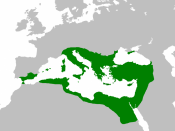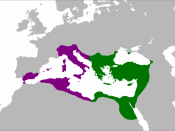Although we speak of the "fall" Rome, the Roman Empire did not disappear from
the map in 476. This dramatic phrase is short for a long and slow process of change from
one life to another. In fact, an emperor still ruled the eastern Roman Empire that was later
named the Byzantine Empire, this would last for another 1000 years.
The Byzantine Empire began with the Roman emperor Constantine in 330 and
ended in 1453 when Constantinople falls to the Turks. He decided to construct his capital
in a town called Byzantium, later called Constantinople or the "New Rome Which Is
Constantine's City." Constantine had several reasons for building his capital there. First,
it was easily defended since it was surrounded by water on three sides and it was
crossroads of trade. Secondly, the hills allowed citizens to spot invading ships or armies
far away. Lastly, it enabled them to control land routes used by merchants.
The Byzantine Empire was the "new Rome," because there were many
similarities between the two cities in areas such as religion. Both these civilization
believed in Christianity, even though they did things differently such as the priests of the
Byzantine faith may marry or get a divorce depending on the situation. Another similarity
between the two is in the economy. Both of these empires had once controlled import
trade routes from sea and land, which made them immensely rich.
The two empires also had identical governments. Emperors who were an autocrat
or a sole ruler with complete authorithy ruled them both. In addition, their codes of law
were very similar. The Byzantine emperor Justinian had ordered to collect, revise, and
organize all the laws of ancient Rome. The result was Corpus Juris Civilis, "Body of
Civil Law" popularly known as Justinian's Code. This massive...



Yea...
the information...was nice...but ur title "Fall of Rome" it sounds like this essay is talking about how Rome fell...a title like "Rome after the fall of Rome" would be nice...
0 out of 0 people found this comment useful.